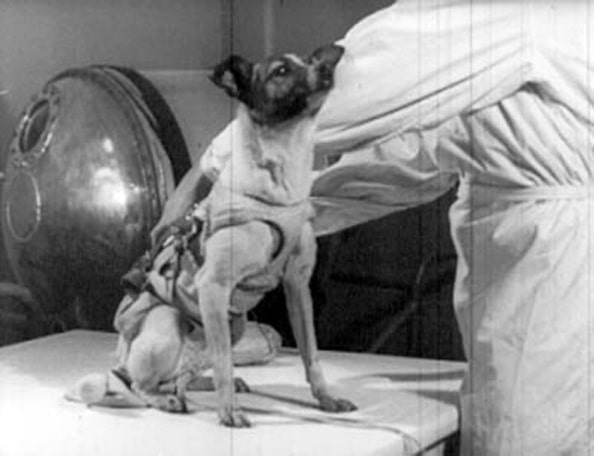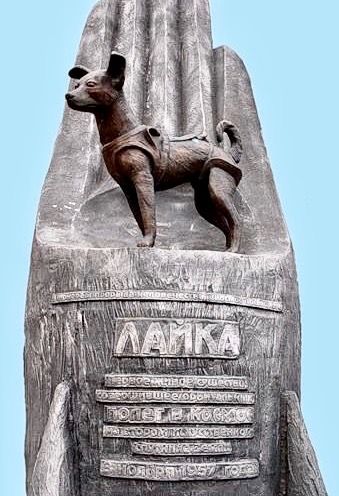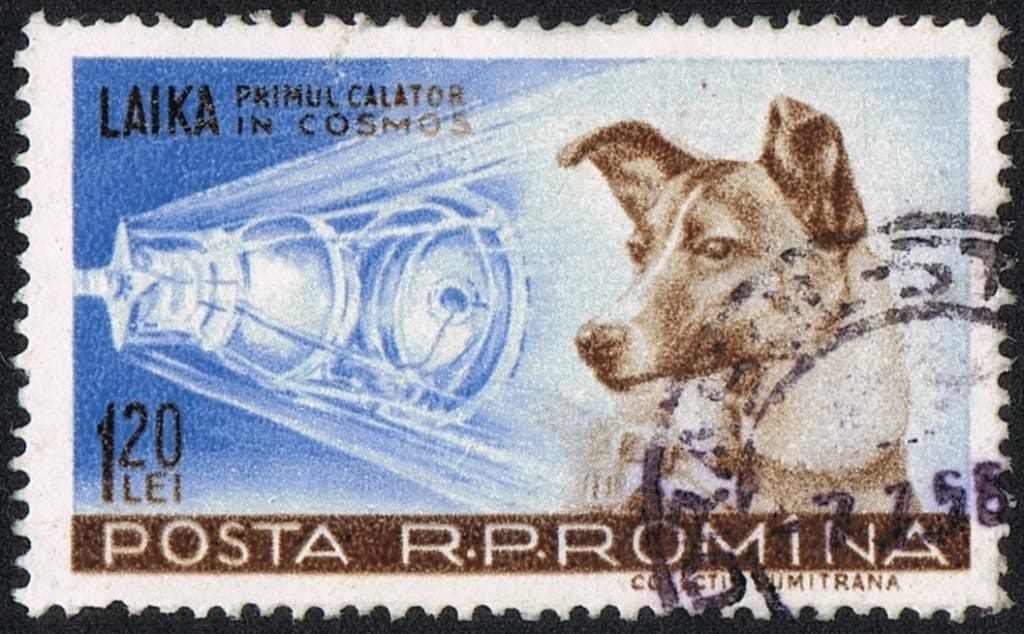“Laika was quiet and charming”
Dr. Vladimir Yazdovsky wrote in his book chronicling the story of Soviet space medicine. She was one of several dogs that gave their lives for the space race in the 1950s and ‘60s. The Soviet Union and the United States used test animals to figure out whether humans could survive outside of the earth’s atmosphere.

Table Of Contents
Where Did the Soviets Find Laika?
Why Did the Soviets Choose Laika?
What Breed Was Laika?
Why Was a Stray Dog the Best Fit for the Mission?
The Story Behind Her Name…
Why Did Soviets Send Dogs into Space?
Her mission : The First Living Creature to Orbit Earth
The Sputnik 2 Spacecraft
What Went Wrong?
How Did Laika Die? The Truth About Her Death
How Long Did Laika Live in Space?
Is Laika Still in Space?
How Did the World React to Laika’s Story?
Remembering Laika…
Laika’s Legacy
Scientists in the Soviet Union collected stray dogs to use in their space program in the 1950s. Laika and five other female pooches came from the streets of Moscow before they started training for their missions. Researchers selected Laika for the Sputnik 2 project nine days before the launch date. This two or three-year-old pup was a good-natured, small gal who quickly won the hearts of the watching world.

“From three dogs — Albina, Mushka, myself — I was selected for this mission.”But, why did they choose her over the other pups?
She Was Photogenic
Nikita Khruschev wanted a spectacular event to mark the 40th anniversary of the Bolshevik Revolution, and Sputnik 2 fit the bill. The mission coordinators were looking for a pooch that would play well to the public. Laika had an endearing quizzical expression and a brightly-colored coat that made her an excellent candidate.
She Was the Right Size
The small capsule and spacesuit were limiting factors. Scientists needed a diminutive dog that was not too tiny. Laika weighed in at about 13 pounds, and she fit in the confined space.
She Had a Calm Demeanor
Launching into space is stressful even for humans. The researchers wanted a pup that was less prone to panic than a high-strung animal. Laika was calm and handled the training sessions without showing excitement.
She Was a Stray
Soviet scientists targeted stray dogs for their missions. They believed life on the street prepared the canines for the rigors of space travel better than if they lived in the comforts of a house.
She Was Female
Sputnik 2 was a small capsule, and the spacesuit was confining. Soviet scientists, Adilya Kotovskaya explains,
"We chose bitches because they don't have to raise a leg to urinate which means they need less space than the males."Of six rescued dogs, Laika, Albina, and Mushka met the above criteria and successfully completed the training. But Albina was a new mother. Not only this, but Laika had promising results in the centrifuge tests and with managing extremely tight quarters.

Nobody knows Laika’s breed for sure because she was a stray mongrel and DNA testing wasn’t available in the 1950s. Mongrel is a word used to describe a pup that has a mixture of breeds in its ancestry.
Spitz Dogs
-
- Akita
- Basenji
- Chow Chow
- Husky varieties
- Laika varieties
- Spitz varieties
Laika Breeds

“And (we chose) strays because they are more resourceful and less demanding.”These dogs, they expected, would be more resilient and better able to manage the challenges associated with launch and orbit. In the case of Sputnik 2, the launch was a one-way mission. The satellite was designed and built in less than a month, and there was not enough time to prepare it for safe re-entry. By using a stray pooch, the scientists would not be sacrificing someone’s furbaby for the space program.
In the 1950s, space was an unknown frontier. Neither the Soviets nor the Americans knew whether humans could survive outside of the earth’s atmosphere. Bill Britz, an American veterinarian who worked with chimpanzees that flew to space in the early 1960s, shared,
“We take for granted now that animals and humans can function in space, but back then we knew absolutely nothing.”
Before they launched a man into orbit, scientists from the United States used chimpanzees to decide whether people could stay alive in outer space. But the Soviets relied on canines for their space trials.
Why?...
Dogs were easier to obtain
Strays abounded in Moscow, and they were free.
Primates could pass diseases to humans
When chimpanzees from Africa arrived at Hollman Airforce Base, eight of the nine veterinarians that cared for them caught hepatitis from the animals.
Soviet scientists had a history using canines in research
Ivan Pavlov used dogs in his research on classical conditioning.
The Soviet Union didn’t need a button pusher
The first cosmonauts would only use manual controls in case of an emergency. Mission control activated the Soviet capsules from the ground.
The Soviets briefly considered launching a chimpanzee.
When they talked to monkey handlers at the circus, they changed their minds because they were told the animals were “too high strung.”
Her mission

Hasty Training

- They moved her into progressively smaller cages to get her used to the cramped quarters of the space capsule.
- They placed her in a centrifuge-style flight simulator that mirrored the G-forces associated with blast-off.
- They exposed her to noise levels like those she would experience on the mission.
- They fed her jellified food similar to the rations she would get in space.
The Mission

Laika’s Quarters

Monitoring Laika


“Of course we knew she was destined to die on the flight since there was no way to get her back”,said Kotovskaya. The space program scientists hoped Laika would live about 7 days before running out of oxygen. Then, the automated feeding system would give the food that contained poison to euthanize her humanely.
The Soviet’s Story


Now and Then...
- Animal Rights groups in Great Britain campaigned to stop the launch. The Royal Society for the Prevention of Cruelty to Animals encouraged citizens to contact the Soviet Union’s embassy in London to voice their disapproval.
- The media chimed in with protest pieces.The Daily Mirror in Britain ran a story with the headline, “THE DOG WILL DIE, WE CAN’T SAVE IT”.
- Musical artists Wil Wagner and Kill Hannah wrote songs bemoaning Laika’s fate.
- The world’s response confused the scientists in the space program. The Soviets issued a statement:
“The Russians love dogs. This has been done not for the sake of cruelty but for the benefit of humanity.”
“The more time passes, the more I’m sorry about it. We shouldn’t have done it. We did not learn enough from the mission to justify the death of the dog.”Today, space programs are more likely to use invertebrates like insects and worms for space research. Martin Barstow, director of the Leicester Institute of Space and Earth Observation shared,
“We’re a bit more alert to the nuances of whether or not you should test anything on animals these days.”
Laika Statue

Romanian Laika Stamp: 1959

Books

T-shirts

Laika’s mission paved the way for mankind to break the space barrier.




6 thoughts on “The Untold Story of Laika: The First Astronaut Dog in Space & the Communist Sputnik 2 mission”
What a precious sacrifice I’m glad that she’ll go down in infamy famous forever and numbered amongst the Stars
She has and forever will be my personal hero. Sleep well Space Puppy. I love you.
So have does it feel to do that to her
U took her life
U didn’t get Nothing out of it
Except killing her
I heard as a child about Laika. I was so, so sad. In my prayers Laika stands for all the animals that where abused by humans.
Laika is and will be forever in my heart, she is my dog.
It should not be forgotten that Sergej Korolev, the chief designer of the Soviet space programme, had a very personal relationship with Laika. When he realized that there was no possibility to bring her back alive, he felt very guilty. I think he would have done anything to rescue her, but the technology at these times was simply not developed enough.
Later on, other dogs were launched under Korolevs directorate, and some like Bjelka and Strjelka successfully returned to earth alive. Some dogs (like Otvazhnaya) even liked the space-flights so much that they were allow multiple launches. Some had a happy life after their space adventures, and even gave birth to puppies. Laika was the pioneer, and its good that her sad death is not forgotten. Because of her tragedy, she is the most honoured space dog of all in Russia, and several monuments were errected to commemorate her.
Love this, an unexpected stray turned into a legend, Laika will always have a special place in my heart.